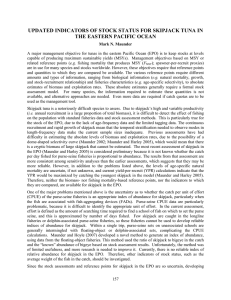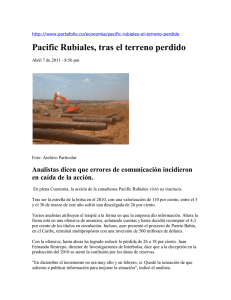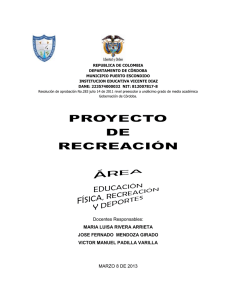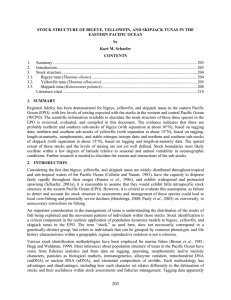STATUS OF SKIPJACK TUNA IN THE EASTERN PACIFIC OCEAN
Anuncio
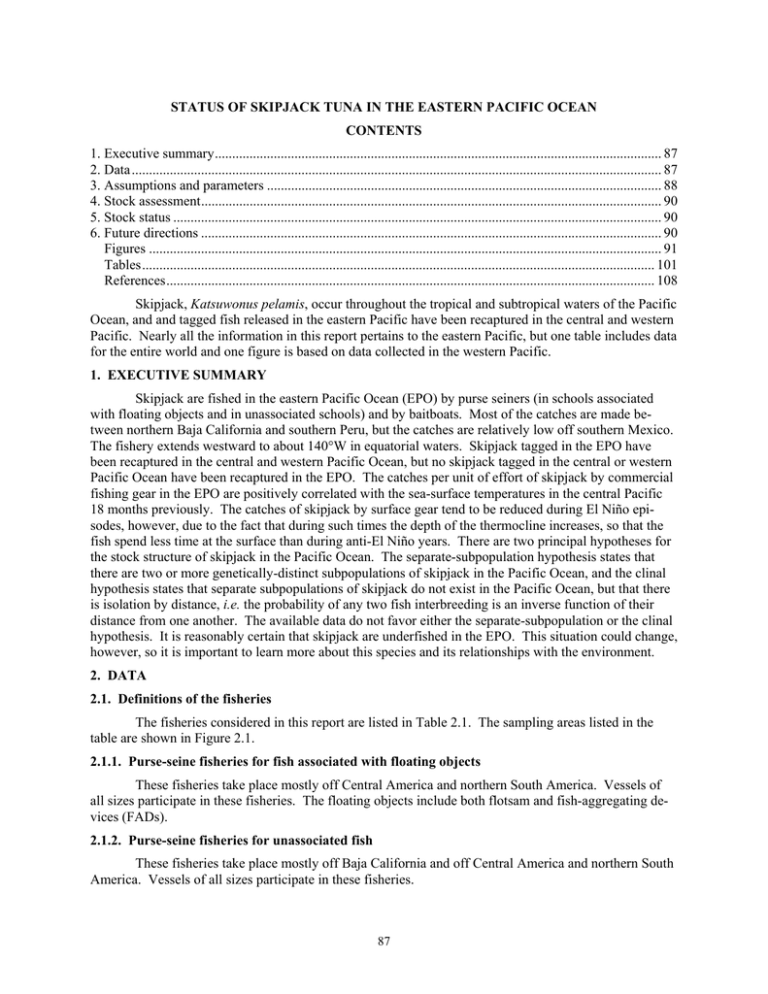
STATUS OF SKIPJACK TUNA IN THE EASTERN PACIFIC OCEAN CONTENTS 1. Executive summary................................................................................................................................. 87 2. Data ......................................................................................................................................................... 87 3. Assumptions and parameters .................................................................................................................. 88 4. Stock assessment..................................................................................................................................... 90 5. Stock status ............................................................................................................................................. 90 6. Future directions ..................................................................................................................................... 90 Figures .................................................................................................................................................... 91 Tables.................................................................................................................................................... 101 References............................................................................................................................................. 108 Skipjack, Katsuwonus pelamis, occur throughout the tropical and subtropical waters of the Pacific Ocean, and and tagged fish released in the eastern Pacific have been recaptured in the central and western Pacific. Nearly all the information in this report pertains to the eastern Pacific, but one table includes data for the entire world and one figure is based on data collected in the western Pacific. 1. EXECUTIVE SUMMARY Skipjack are fished in the eastern Pacific Ocean (EPO) by purse seiners (in schools associated with floating objects and in unassociated schools) and by baitboats. Most of the catches are made between northern Baja California and southern Peru, but the catches are relatively low off southern Mexico. The fishery extends westward to about 140°W in equatorial waters. Skipjack tagged in the EPO have been recaptured in the central and western Pacific Ocean, but no skipjack tagged in the central or western Pacific Ocean have been recaptured in the EPO. The catches per unit of effort of skipjack by commercial fishing gear in the EPO are positively correlated with the sea-surface temperatures in the central Pacific 18 months previously. The catches of skipjack by surface gear tend to be reduced during El Niño episodes, however, due to the fact that during such times the depth of the thermocline increases, so that the fish spend less time at the surface than during anti-El Niño years. There are two principal hypotheses for the stock structure of skipjack in the Pacific Ocean. The separate-subpopulation hypothesis states that there are two or more genetically-distinct subpopulations of skipjack in the Pacific Ocean, and the clinal hypothesis states that separate subpopulations of skipjack do not exist in the Pacific Ocean, but that there is isolation by distance, i.e. the probability of any two fish interbreeding is an inverse function of their distance from one another. The available data do not favor either the separate-subpopulation or the clinal hypothesis. It is reasonably certain that skipjack are underfished in the EPO. This situation could change, however, so it is important to learn more about this species and its relationships with the environment. 2. DATA 2.1. Definitions of the fisheries The fisheries considered in this report are listed in Table 2.1. The sampling areas listed in the table are shown in Figure 2.1. 2.1.1. Purse-seine fisheries for fish associated with floating objects These fisheries take place mostly off Central America and northern South America. Vessels of all sizes participate in these fisheries. The floating objects include both flotsam and fish-aggregating devices (FADs). 2.1.2. Purse-seine fisheries for unassociated fish These fisheries take place mostly off Baja California and off Central America and northern South America. Vessels of all sizes participate in these fisheries. 87 2.1.3. Purse-seine fishery for fish associated with dolphins Only small amounts of skipjack are caught in sets on dolphin-associated tunas. Only larger vessels participate in this fishery. 2.1.4. Baitboat fisheries Most of the catches of yellowfin, skipjack, and bigeye prior to about 1960 were taken by baitboats. These vessels fished from Southern California to northern Chile. The fishery took place mostly within about 250 nautical miles of the coast and in the vicinity of a few offshore islands. There are only a few baitboats left now, all of which are registered in Ecuador, Mexico, or the United States (Anonymous, 2000: Table 2). These vessels are all small, and they fish relatively close to shore off Ecuador, northern Mexico, and Southern California. 2.1.5. Longline fisheries Only small amounts of skipjack are caught with longlines (Miyake, 1968). 2.1.6. Artisanal fisheries Artisanal fishermen catch small amounts of skipjack near the coast of the Americas from Mexico to Peru. 2.2. Catch and effort data Data on the catches of skipjack in the EPO, the western and central Pacific Ocean, and the Atlantic and Indian Oceans are shown in Table 2.2. 2.2.1. Purse-seine fisheries The distributions of the purse-seine catches of skipjack and of purse-seine fishing effort in the EPO during 1983-1997 are shown in Figure 2.2.1a. The monthly catches and effort are shown in Figures 2.2.1b and 2.2.1c, respectively. 2.2.2. Baitboat fisheries The distributions of the catches of skipjack by baitboats in the EPO during 1958 are shown in Figure 2.2.2. The monthly catches and effort are shown in Figures 2.2.1b and 2.2.1c (Fishery 8), respectively. 2.3. Size composition data 2.3.1. Purse-seine fisheries Length-frequency data for skipjack caught in the EPO during 1993-1998 are shown in Figure 2.3.1. Small amounts of baitboat-caught fish are included in the samples. 2.3.2. Baitboat fisheries Length-frequency data for skipjack caught in the EPO by baitboats during 1956 are shown in Figure 2.3.2. 3. ASSUMPTIONS AND PARAMETERS 3.1. Biological and demographic information 3.1.1. Growth The IATTC staff has used a growth rate of 24 cm per year, from Forsbergh (1989), in its yieldper-recruit modeling of skipjack. Bayliff (1988) used tagging data to calculate the following estimates for the parameters of the von Bertalanffy growth equation: 88 Method ungrouped grouped K (annual) 0.658 0.829 L∞ (millimeters) 885 846 (With the grouped method all fish that were in the same size-at-release (275-324 mm, 325-374 mm, etc.) and time-at-liberty (31-40 days, 41-50 days, etc.) groups were combined and treated as single fish) to reduce the influence of groups containing large numbers of fish.) Estimates of the lengths of fish at various ages, calculated from the above estimates of the parameters, are shown in Table 3.1.1a. It should be noted, however, that the results of sensitivity analyses performed by Bayliff (1988) indicated that the estimates of the parameters were imprecise. Data on the weight-length relationships of skipjack in the EPO are listed in Table 3.1.1b. 3.1.2. Reproduction Information on the reproduction of skipjack in the EPO is given by Anonymous (1998: 26). Spawning is fairly widespread between about 15°N and 10°S from the coast of the Americas to about 130°W at sea-surface temperatures (SSTs) equal to or greater than 25°C. 3.1.3. Movement Information of the movements of skipjack in the EPO is given by Schaefer et al. (1961), Fink and Bayliff (1970), and Hunter et al. (1986). The distances travelled by skipjack released in the western Pacific that were at liberty 0 to 30 days, 31 to 180 days, and more than 180 days are shown in Figure 3.1.3. The percentages of fish that travelled more than 500 nautical miles are 0, about 5, and about 30, respectively, for the three groups. Twenty-seven tagged skipjack released in the EPO have been recaptured in the central or western Pacific (Bayliff, 1988: Appendix 2), but no tagged skipjack released in the central or western Pacific have been recaptured in the EPO. It should be recognized that the amounts of tagged fish recaptured at various locations are dependent on the amounts of fishing effort in those locations. If tagging experiments are initiated where the fishing effort is heavy the distances moved by the fish that are recaptured are likely to be less than they would have been if the tagged fish had been released in areas of both heavy and light fishing. 3.1.4. Natural mortality Attempts to estimate the natural mortality rate (M) of skipjack, and the many problems associated with these studies, are discussed by Wild and Hampton (1994). The IATTC staff has used a value of 1.5, on an annual basis, for M in yield-per-recruit analyses (Anonymous, 2000: 69). 3.1.5. Stock structure Skipjack occur throughout the tropical and subtropical waters of the Pacific Ocean, and it is known that there is considerable exchange of fish among areas (Figure 3.1.5). The stock structure of skipjack has been studied by various methods, including analyses of catch statistics, life history, tagging, biochemical genetic data, and data on the chemical composition of the otoliths of the fish. Research in these fields has been conducted by many organizations, including the IATTC, the South Pacific Commission (now the Secretariat of the Pacific Community; SPC), the U.S. National Marine Fisheries Service (NMFS), and various organizations in Japan. The research results pertinent to a solution to this problem were examined by Argue (1981), and the conclusions reached at that meeting were discussed in detail by Anonymous (1984: 88-91). In summary, there were two principal hypotheses for skipjack in the Pacific Ocean. The separate-subpopulation hypothesis stated that there are two or more genetically-distinct subpopulations of skipjack in the Pacific Ocean, and the clinal hypothesis stated that separate subpopulations of skipjack do not exist in the Pacific Ocean, but that there is isolation by distance, i.e. the probability of any two fish interbreeding is an inverse function of their distance from one another. It was concluded by Argue (1981) that the available data did not favor either the separate-subpopulation or the clinal hypothesis. Subsequent studies, described by Anonymous (1995: 69-71) have not furnished information that 89 would serve better as the basis for management decisions. (Those studies should not be considered as futile, however, as the information from them may eventually be combined with information to be gathered in the future to achieve a greater understanding of the stock structure of skipjack in the Pacific Ocean.) 3.2. Environmental influences The influences of some environmental variables on the apparent abundance of skipjack in the EPO are discussed by Forsbergh (1989). The abundance of skipjack larvae in the central and western Pacific approximately doubles with each 1-degree increase in SST from 23°C to a maximum of 29°C. The catches per unit of effort (CPUEs) of skipjack by commercial fishing gear in the EPO are positively correlated with the SSTs in the central Pacific 18 months previously. The catches of skipjack by surface gear tend to be reduced during El Niño episodes, however, due to the fact that during such times the depth of the thermocline increases, so that the fish spend less time at the surface than during anti-El Niño years (Joseph and Miller, 1989). 4. STOCK ASSESSMENT The staff has not completed its stock assessment of skipjack; this will be presented at a later date. 5. STOCK STATUS Information on the status of skipjack in the EPO is presented by Anonymous (2000). It is reasonably certain that skipjack are underfished in the EPO. This situation could change, however, so it is important to learn more about this species and its relationships with the environment. 6. FUTURE DIRECTIONS A-SCALA (Age-Structured Statistical Catch-at-Length Analysis), based on MULTIFAN-CL (Fournier et al., 1998), will be used for skipjack in the near future. 90 FIGURE 2.1. Areas used for sampling tunas for species composition and length frequencies. FIGURA 2.1. Zonas usadas para muestrear la composición por especies y frecuencia de talla de atunes. 91 FIGURE 2.2.1a. Average annual catches of skipjack and average annual fishing effort in the EPO during 1983-1997 for all purse-seine trips for which usable logbook data were obtained. The average catches and effort were calculated only for 1-degree areas for which three or more years of data were available. FIGURA 2.2.1a. Capturas anuales medias de barrilete y esfuerzo de pesca anual medio en el OPO durante 1983-1997 para todos los viajes de buques cerqueros de los cuales se obtuvieron datos utilizables. Se calcularon las capturas y esfuerzo medios solamente para zonas de 1° para las que se dispuso de tres o más años de datos. 92 93 FIGURE 2.2.1b. Monthly catches of skipjack by the various fisheries listed in Table 2.1. FIGURA 2.2.1b. Capturas mensuales de barrilete por las varias pesquerías detalladas en la Tabla 2.1. 93 94 FIGURE 2.2.1c. Monthly amounts of fishing effort for the various fisheries listed in Table 2.1. FIGURA 2.2.1c. Cantidad mensual de esfuerzo de pesca para las varias pesquerías detalladas en la Tabla 2.1. 94 FIGURE 2.2.2. Distributions of catches of skipjack by baitboats in the EPO during 1958 (from Alverson, 1959: Figures 62-65). FIGURA 2.2.2. Distribuciones de capturas de barrilete por barcos de carnada en el OPO durante 1958 (de Alverson, 1959: Figuras 62-65). 95 FIGURE 2.2.2. (continued) FIGURA 2.2.2. (continuación) 96 FIGURE 2.3.1. Estimated catches of skipjack in the EPO. The values in the upper right corners of the panels are average weights. FIGURA 2.3.1. Capturas estimadas de barrilete en el OPO. El valor en la esquina superior derecha de cada recuadro es el peso promedio. 97 FIGURE 2.3.2. Length frequencies of skipjack caught by baitboats in four areas of the EPO during 1956 (after Matsumoto et al., 1984: Figure 62). FIGURA 2.3.2. Frecuencias de talla de barrilete capturado por barcos de carnada en cuatro zonas del OPO durante 1956 (de Matsumoto et al., 1984: Figura 62). 98 FIGURE 3.1.3. Net distances, in nautical miles, traveled by tagged baitboat-caught skipjack released in the western Pacific Ocean during 1977-1980 (after Hunter et al., 1986: Figure 10). FIGURA 3.1.3. Distancias netas, en millas náuticas, recorridas por barriletes capturados y marcados en barcos de carnada liberados en el Océano Pacífico occidental durante 1977-1980 (de Hunter et al., 1986: Figura 10). 99 FIGURE 3.1.5. Some long-distance movements recorded for skipjack in the Pacific Ocean. FIGURA 3.1.5. Desplazamientos a larga distancia registrados para barriletes en el Océano Pacífico. 100 TABLE 2.1. Fisheries for skipjack tuna in the eastern Pacific Ocean considered in this report, based on data for 1985-1999. The sampling areas are shown in Figure 2.1. The discards for Fisheries 1-7 are the result of inefficiencies in the fishing process, whereas those in Fisheries 10-13 consist of fish that were too small to be marketable. PS: purse seine; BB: baitboat; LL: longline TABLA 2.1. Pesquerías de atún barrilete en el Océano Pacífico oriental consideradas en este informe, basadas en datos de 1985-1999. En la Figura 2.1 se ilustran las zonas de muestreo. Los descartes en las Pesquerías 1-7 resultan de ineficacias en el proceso de pesca, mientras que los de las Pesquerías 10-13 consisten de peces demasiado pequeños para vender. PS: red de cerco; BB: carnada; LL: palangre. Fishery Gear Pesquería Arte 1 2 3 4 5 6 7 8 9 PS PS PS PS PS PS PS BB LL 10 PS 11 PS 12 PS 13 PS Purse-seine set type Tipo de lance cerquero Floating object — Objeto flotante Unassociated— No asociado Dolphin--Delfín ------- Sampling areas Zonas de muestreo 11-12 7, 9 5-6, 13 1-4, 8, 10 1-4, 8, 10 5-7, 9, 11-13 1-13 1-13 1-13 11-12 Floating object — Objeto flotante 7, 9 5-6, 13 1-4, 8, 10 101 Catch data Datos de captura Landings + discards—Descargas y descartes Landings only--Descargas solamente Discards of small fish in Fishery 1—Descartes de peces pequeños en la Pesquería 1 Discards of small fish in Fishery 2—Descartes de peces pequeños en la Pesquería 2 Discards of small fish in Fishery 3—Descartes de peces pequeños en la Pesquería 3 Discards of small fish in Fishery 4—Descartes de peces pequeños en la Pesquería 4 TABLE 2.2. Annual catches of skipjack tuna, in thousands of metric tons. WCPO = western and central Pacific Ocean. TABLA 2.2. Capturas anuales de atún barrilete, en miles de toneladas métricas. OPOC = Océano Pacífico occidental y central. Year Año 1970 1971 1972 1973 1974 1975 1976 1977 1978 1979 1980 1981 1982 1983 1984 1985 1986 1987 1988 1989 1990 1991 1992 1993 1994 1995 1996 1997 1998 Pacific Ocean WCPO3 Eastern Retained1 Discarded2 retained Océano Pacífico Oriental OPOC3 1 2 retenido Retenido Descartado 56.0 * 251.5 104.7 * 245.6 33.4 * 310.7 44.0 * 400.8 78.8 * 440.6 123.9 * 339.0 126.2 * 428.6 86.3 * 416.6 169.8 * 522.1 132.0 * 462.0 130.7 * 496.1 119.6 * 446.8 98.8 * 469.4 58.1 * 653.6 60.6 * 766.6 49.5 * 608.9 63.6 * 750.0 62.3 * 691.3 85.3 * 854.0 92.4 * 774.6 72.6 * 869.4 63.3 * 1,194.9 84.0 * 927.4 87.4 10.6 924.1 74.5 10.3 982.3 138.2 16.6 1,021.2 112.2 25.0 1,009.6 161.5 31.9 883.3 141.6 22.9 * 4 Total retained Total4 retenido 307.5 350.3 344.1 444.8 519.4 462.9 554.8 502.9 691.9 594.0 626.8 566.4 568.2 711.7 827.2 658.4 813.6 753.6 939.3 867.0 942.0 1,258.2 1,011.4 1,011.5 1,056.8 1,159.4 1,121.8 1,044.8 * 1 Atlantic Ocean4 retained Océano Atlántico4 retenido 44.0 70.0 75.0 74.4 111.1 60.0 68.1 108.7 99.9 86.5 106.4 130.6 154.6 134.4 130.7 116.7 124.1 114.3 139.4 114.4 133.1 193.4 152.3 181.9 171.9 159.8 137.8 137.1 * Source: Anonymous, 2000: Table 3—Fuente: Anónimo, 2000: Tabla 3 Source: Anonymous, 2000: Table 39—Fuente: Anónimo, 2000: Tabla 39 3 Column 5 minus Column 2—Columna 5 menos Columna 2 4 Source: Anonymous, 2000: Table 6a—Fuente: Anónimo, 2000: Tabla 6a * not available—no disponible 2 102 Indian Ocean4 retained Océano Indico4 retenido 41.5 41.1 35.7 34.1 39.5 35.2 38.6 30.3 30.5 36.0 47.3 47.3 52.6 63.8 103.2 136.8 150.0 169.5 210.1 249.8 218.4 215.1 266.2 248.5 269.8 254.0 237.8 243.7 * Total4 retained Total4 retenido 393.1 461.4 454.8 553.3 670.0 558.1 661.5 642.0 822.3 716.5 780.5 744.3 775.4 909.9 1,061.1 911.9 1,087.7 1,037.3 1,288.8 1,231.1 1,293.5 1,666.7 1,429.8 1,441.9 1,498.4 1,573.3 1,497.5 1,425.6 * TABLE 3.1.1a. Estimated lengths, in centimeters, at age of skipjack, calculated from the parameters of Bayliff (1988). TABLA 3.1.1a. Tallas estimadas (cm) de barrilete a edad, calculadas de los parámetros de Bayliff (1988). Ungrouped – No agrupado Grouped--Agrupado Age in years—Edad en años 2 3 4 65 76 82 68 78 82 1 43 48 5 85 83 TABLE 3.1.1b. Equations for converting lengths, in centimeters, to weights, in kilograms, for skipjack. The fish were measured from the tip of the snout to the fork of the tail, and weighed whole. Each measurement was given equal weight for the pooled method, whereas the combined measurements for each sampling areas were given equal weight for the equal-area method. TABLE 3.1.1b. Ecuaciones para convertir tallas, en centímetros, a pesos, en kilogramos, para barrilete. Se midieron los peces de la punta del hocico a la furca caudal, y se pesaron enteros. Se asignó a cada medida el mismo peso para el método agrupado, mientras que para el método de zonas iguales se asignó el mismo peso a las medidas combinadas para cada zona de muestreo. Area Method Zona Método Pooled-Agrupado Equal-area— EPO--OPO Zonas iguales EPO--OPO Sample size Tamaño muestra Length range (cm) Rango de tallas (cm) 1,282 39-71 1,282 39-71 Equations Reference Ecuaciones -6 3.336 w = (5.5293 x 10 )l logw = 3.336logl – 5.2573 w = (3.1453 x 10-6)l3.265 logw = 3.265logl – 5.203 103 Referencia Hennemuth, 1959 Hennemuth, 1959 CONDICION DEL ATUN BARRILETE EN EL OCEANO PACIFICO ORIENTAL INDICE 1. Resumen ejecutivo ................................................................................................................................ 104 2. Datos ..................................................................................................................................................... 104 3. Supuestos y parámetros......................................................................................................................... 105 4. Evaluación de stocks............................................................................................................................. 107 5. Condición del stock............................................................................................................................... 107 6. Direcciones futuras ............................................................................................................................... 107 Figuras .................................................................................................................................................... 91 Tablas.................................................................................................................................................... 101 Referencias............................................................................................................................................ 108 El atún barrilete (Katsuwonus pelamis) ocurre en aguas tropicales y subtropicales del Océano Pacífico entero, y se han recapturado en el Pacífico central y occidental peces marcados liberados en el Pacífico oriental. Casi toda la información en este informe es del Pacífico oriental, pero una tabla incluye datos del mundo entero y una figura se basa en datos tomados en el Pacífico occidental. 1. RESUMEN EJECUTIVO El barrilete es pescado en el Océano Pacífico oriental (OPO) por buques cerqueros (en cardúmenes asociados con objetos flotantes y en cardúmenes no asociados) y por barcos de carnada. Se realiza la mayoría de las capturas entre el norte de Baja California y el sur del Perú, pero con capturas relativamente bajas frente al sur de México. La pesquería se extiende hacia el oeste hasta aproximadamente 140°O en aguas ecuatoriales. Barriletes marcados en el OPO han sido recapturados en el Océano Pacífico central y occidental, pero no se han recapturado en el OPO barriletes marcados en el Océano Pacífico central o occidental. Las capturas por unidad de esfuerzo de barrilete por artes de pesca comerciales en el OPO están correlacionadas positivamente con las temperaturas superficiales del mar en el Pacífico central 18 meses antes. Las capturas de barrilete por artes de superficie suelen disminuir durante eventos de El Niño pero, debido a que durante estos eventos aumenta la profundidad de la termoclina y los peces pasan menos tiempo en la superficie que durante años de La Niña. Hay dos hipótesis principales sobre la estructura de stocks del barrilete en el Océano Pacífico. La hipótesis de subpoblaciones separadas postula que existen dos ó más subpoblaciones de barrilete genéticamente distintas en el Océano Pacífico, y la hipótesis clinal que no existen subpoblaciones separadas de barrilete en el Océano Pacífico, pero que hay aislamiento por distancia – es decir, la probabilidad de hibridación de dos peces dados es una función inversa de la distancia entre los dos. Los datos disponibles no permiten decidir a favor de una ni otra hipótesis. Queda bastante seguro que el barrilete es subexplotado en el OPO, pero esta situación podría cambiar, por lo que es importante mejorar los conocimientos de la especie y su relación con el medio ambiente. 2. DATOS 2.1. Definiciones de las pesquerías En la Tabla 2.1 se detallan las pesquerías consideradas en este informe. En la Figura 2.1 se ilustran las zonas de muestreo listadas en la tabla. 2.1.1. Pesquerías cerqueras de peces asociados con objetos flotantes Estas pesquerías tienen lugar principalmente frente a Centroamérica y el norte de América del Sur. Participan buques de todos tamaños. Los objetos flotantes incluyen objetos naturales y dispositivos agregadores de peces (DAP, o plantados). 2.1.2. Pesquerías cerqueras de peces no asociados Estas pesquerías tienen lugar principalmente frente a Baja California y frente a Centroamérica y el norte de América del Sur. Participan buques de todos tamaños. 104 2.1.3. Pesquerías cerqueras de peces asociados con delfines Se capturan solamente cantidades pequeñas de barrilete en lances sobre atunes asociados con delfines. Participan solamente buques mayores. 2.1.4. Pesquerías con carnada Antes de aproximadamente 1960 los barcos de carnada respondían de la mayoría de las capturas de atunes aleta amarilla, barrilete, y patudo. Estos barcos pescaban desde el sur de California hasta el norte de Chile. La pesquería tenía lugar principalmente a menos de 250 millas náuticas de la costa y cerca de unas pocas islas de altura. Ahora quedan solamente unos pocos barcos de carnada, todos matriculados en Ecuador, México, o Estados Unidos (Anónimo 2000: Tabla 2). Son buques pequeños, y pescan relativamente cerca de la costa frente a Ecuador, el norte de México, y el sur de California. 2.1.5. Pesquerías palangreras Se capturan solamente pequeñas cantidades de barrilete con palangre (Miyake, 1968). 2.1.6. Pesquerías artesanales Pescadores artesanales capturan cantidades pequeñas de barrilete cerca del litoral de las Américas entre México y Perú. 2.2. Datos de captura y esfuerzo En la Tabla 2.2 se presentan datos sobre las capturas de barrilete en el OPO, el Océano Pacífico occidental y central, y los Océanos Atlántico e Indico. 2.2.1. Pesquerías de cerco En la Figura 2.2.1a se presentan las distribuciones de las capturas cerqueras de barrilete y del esfuerzo de pesca con cerco en el OPO durante 1983-1997. En las Figuras 2.2.1b y 2.2.1c se presentan las capturas y el esfuerzo mensuales, respectivamente. 2.2.2. Pesquerías con carnada En la Figura 2.2.2 se presentan las distribuciones de las capturas de barrilete por barcos de carnada en el OPO durante 1958. En las Figuras 2.2.1b y 2.2.1c (Pesquería 8) se presentan las capturas y el esfuerzo mensuales, respectivamente. 2.3. Datos de composición por tamaño 2.3.1. Pesquerías de cerco En Figura 2.3.1 se presentan datos de frecuencia de talla de barriletes capturados en el OPO durante 1993-1998. Se incluyen en las muestras pequeñas cantidades de pescado capturado por barcos de carnada. 2.3.2. Pesquerías con carnada En Figura 2.3.2 se presentan datos de frecuencia de talla de barriletes capturados en el OPO por barcos de carnada durante 1956. 3. SUPUESTOS Y PARAMETROS 3.1. Información biológica y demográfica 3.1.1. Crecimiento El personal de la CIAT usa una tasa de crecimiento de 24 cm/año, de Forsbergh (1989), en sus modelos de rendimiento por recluta de barrilete. Bayliff (1988) usó datos de marcado para calcular las siguientes estimaciones de los parámetros de la ecuación de crecimiento de von Bertalanffy: 105 Método no agrupado agrupado K (anual) 0.658 0.829 L∞ (mm) 885 846 (Con el método agrupado se combinaron y trataron como un solo pez todos los peces del mismo grupo de tamaño de liberación (275-324 mm, 325-374 mm, etc.) y tiempo en libertad (31-40 días, 41-50 días, etc.)) para reducir la influencia de grupos con un gran número de peces.) En la Tabla 3.1.1a se presentan estimaciones de las tallas de peces a distintas edades, calculadas de las estimaciones de los parámetros arriba detalladas. Cabe destacar, sin embargo, que los resultados de los análisis de sensibilidad realizados por Bayliff (1988) indicaron que las estimaciones de los parámetros eran imprecisas. En la Tabla 3.1.1b se presentan datos sobre las relaciones peso-talla de barrilete en el OPO. 3.1.2. Reproducción Anónimo (1998: 226-227) presenta información sobre la reproducción de barrilete en el OPO. El desove ocurre en una zona bien amplia entre aproximadamente 15°N y 10°S desde el litoral de las Américas hasta alrededor de 130°O con temperaturas de superficie del mar (TSM) de 25°C o más. 3.1.3. Desplazamientos Schaefer et al. (1961), Fink y Bayliff (1970), y Hunter et al. (1986) presentan información sobre los desplazamientos de barrilete en el OPO. En la Figura 3.1.3 se muestran las distancias recorridas por barriletes liberados en el Pacífico occidental que permanecieron en libertad 0 a 30 días, 31 a 180 días, y más de 180 días. El porcentaje de peces que se desplazaron más de 500 millas náuticas es 0, 5, y 30, respectivamente, para los tres grupos. Han sido recapturados en el Pacífico central u occidental 27 barriletes marcados liberados en el OPO (Bayliff, 1988: Anexo 2), pero no se ha recapturado en el OPO ningún barrilete marcado liberado en el Pacífico central u occidental. Se debe tener en cuenta que la cantidad de peces marcados recapturados en varios lugares depende de la cantidad de esfuerzo de pesca en esos lugares. Si se inicia un experimento de marcado en una zona de esfuerzo de pesca elevado, es probable que las distancias que recorran los peces recapturados sean menores de lo que serían si fuesen liberados en zonas de pesca donde el nivel de esfuerzo de pesca varía. 3.1.4. Mortalidad natural Wild y Hampton (1994) comentan los intentos por estimar la tasa de mortalidad natural (M) de barrilete, y los muchas problemas asociados con esos estudios. El personal de la CIAT usa un valor de 1,5, sobre una base anual, de M en análisis de rendimiento por recluta (Anónimo, 2000: 276). 3.1.5. Estructura del stock El barrilete ocurre en todas las aguas tropicales y subtropicales del Océano Pacífico, y se sabe que ocurre un intercambio considerable de peces entre zonas (Figura 3.1.5). Se han usado varios métodos para estudiar la estructura de stocks del barrilete, entre ellos análisis de las estadísticas de captura, el ciclo vital, el marcado, datos genéticos bioquímicos, y datos de la composición química de los otolitos de los peces. Diversas organizaciones, entre ellas la CIAT, la Comisión del Pacífico Sur (ahora el Secretariado de la Comunidad del Pacífico; SPC), el Servicio Nacional de Pesquerías Marinas (NMFS) de EE.UU., y varias entidades japonesas, han estudiado estos temas. Los resultados de la investigación pertinentes a una solución de este problema fueron analizados por Argue (1981), y las conclusiones de esa reunión fueron analizadas en detalle por Anónimo (1984: 186-189). En resumen, había dos hipótesis principales sobre el barrilete del Océano Pacífico: (1) la hipótesis de subpoblaciones separadas, que postulaba que en el Océano Pacífico existen al menos dos subpoblaciones de barrilete genéticamente distintas; (2) la hipótesis de gradación (o clinal), que sostenía que no existen subpoblaciones separadas de barrilete en el Océano Pacífico, sino que hay aislamiento por distancia: es decir, la probabilidad de hibridación de dos peces dados es 106 una función inversa de la distancia entre los dos. Argue (1981) concluyó que la información disponible no permitía decidir a favor de una ni otra de las dos hipótesis. Estudios posteriores, descritos por Anónimo (1995: 255-257), no produjeron información que sirviera mejor como base para decisiones de ordenación. (Sin embargo, no se deben considerar inútiles esos estudios, ya que es posible que la información que arrojaron sea eventualmente combinada con información reunida en el futuro para lograr una mayor comprensión de la estructura de los stocks de barrilete en el Océano Pacífico.) 3.2. Influencias ambientales Forsbergh (1989) comenta las influencias de ciertas variables ambientales sobre la abundancia aparente de barrilete en el OPO. La abundancia de larvas de barrilete en el Pacífico central y occidental se duplica, aproximadamente, con cada aumento de 1° en las TSM entre 23°C y un máximo de 29°C. Las capturas por unidad de esfuerzo (CPUE) de barrilete por artes de pesca comerciales en el OPO están positivamente correlacionadas con las TSM en el Pacífico central 18 meses antes. Sin embargo, las capturas de barrilete por artes de superficie suelen disminuir durante episodios de El Niño, debido a que durante esos episodios aumenta la profundidad de la termoclina y los peces pasan menos tiempo en la superficie que durante años de La Niña (Joseph y Miller, 1989). 4. EVALUACION DE STOCKS El personal no ha terminado su evaluación del stock de barrilete; será presentada en fecha posterior. 5. CONDICION DEL STOCK Anónimo (2000) presenta información sobre la condición del barrilete en el OPO. Queda bastante seguro que el barrilete es subexplotado en el OPO, pero esta situación podría cambiar, por lo que es importante mejorar los conocimientos de la especie y su relación con el medio ambiente. 6. DIRECCIONES FUTURAS En un futuro cercano se usará A-SCALA (Age-Structured Statistical Catch-at-Length Analysis), basado en MULTIFAN-CL(Fournier et al.,1998), para evaluar los stocks. 107 REFERENCES—REFERENCIAS Alverson, Franklin G. 1960. Distribution of fishing effort and resulting tuna catches from the eastern tropical Pacific by quarters of the year, 1951-1958. Inter-Amer. Trop. Tuna Comm., Bull., 4 (6): 319-446. Anonymous. 1984. Annual Report of the Inter-American Tropical Tuna Commission 1983: 272 pp. Anonymous. 1995. Annual Report of the Inter-American Tropical Tuna Commission 1994: 296 pp. Anonymous. 1998. Annual Report of the Inter-American Tropical Tuna Commission 1996: 306 pp. Anonymous. 2000. Annual Report of the Inter-American Tropical Tuna Commission 1998: 357 pp. Argue, A. W. (editor). 1981. Report of the Second Skipjack Survey and Assessment Programme workshop to review results from genetic analysis of skipjack blood samples. South Pacif. Comm., Skipjack Survey and Assessment Programme, Tech. Rep., 6: v, 39 pp. Bayliff, William H. 1988. Growth of skipjack, Katsuwonus pelamis, and yellowfin, Thunnus albacares, tunas in the eastern Pacific Ocean, as estimated from tagging data. Inter-Amer. Trop. Tuna Comm., Bull., 19 (4): 307-385. Fink, Bernard D., and William H. Bayliff. 1970. Migrations of yellowfin and skipjack tuna in the eastern Pacific Ocean as determined by tagging experiments, 1952-1964. Inter-Amer. Trop. Tuna Comm., Bull., 15 (1): 1-227. Forsbergh, Eric D. 1989. The influence of some environmental variables on the apparent abundance of skipjack tuna, Katsuwonus pelamis, in the eastern Pacific Ocean. Inter-Amer. Trop. Tuna Comm., Bull., 19 (6): 429-569. Fournier, David A., John Hampton, and John R. Sibert. 1998. MULTIFAN-CL: a length-based, agestructured model for fisheries stock assessment, with application to South Pacific albacore, Thunnus alalunga. Canad. Jour. Fish. Aquatic Sci., 55 (9): 2105-2116. Hennemuth, Richard C. 1959. Additional information on the length-weight relationship of skipjack tuna from the eastern tropical Pacific Ocean. Inter-Amer. Trop. Tuna Comm., Bull., 4 (2): 23-37. Hunter, John R., A. W. Argue, William H. Bayliff, Andrew E. Dizon, Alain Fonteneau, Daniel Goodman, and Gunter R. Seckel. 1986. The dynamics of tuna movements: an evaluation of past and future research. FAO Fish. Tech. Pap., 277: vi, 78 pp. Joseph, James, and Forrest R. Miller. 1989. El Niño and the surface fishery for tunas in the eastern Pacific. Japan. Soc. Fish. Ocean., Bull., 53 (-): 77-80. Matsumoto, Walter M., Robert A Skillman, and Andrew E. Dizon. 1984. Synopsis of biological data on skipjack tuna, Katsuwonus pelamis. U.S. Nat. Mar. Fish. Serv., NOAA Tech. Rep. NMFS Circular, 451: 92 pp. Miyake, Makoto Peter. 1968. Distribution of skipjack in the Pacific Ocean, based on records of incidental catches by the Japanese longline tuna fishery. Inter-Amer. Trop. Tuna Comm., Bull., 12 (7): 509-608. Schaefer, Milner B., Bruce M. Chatwin, and Gordon C. Broadhead. 1961. Tagging and recovery of tropical tunas, 1955-1959. Inter-Amer. Trop. Tuna Comm., Bull., 5 (5): 341-455. Wild, Alex, and John Hampton. 1994. A review of the biology and fisheries for skipjack tuna, Katsuwonus pelamis, in the Pacific Ocean. FAO Fish. Tech. Pap., 336 (2): 1-51. 108


